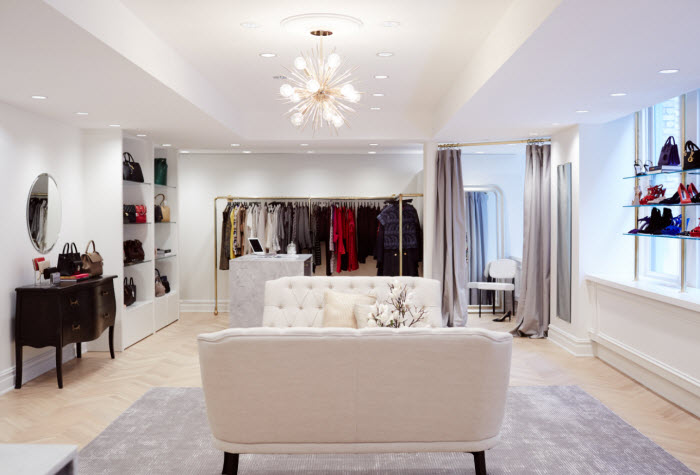The “aha” moment arrived with an evening bag.
Many evening bags, in fact. So many that Gilt could no longer keep them in stock. The online retailer, known for parlaying the concept of flash sales into a shopping pastime, has had a few newsflashes of its own since recently opening Gilt by Appointment, an in-person shopping studio in New York that is exclusive to Gilt members.
Among the key lessons: Gilt shoppers act unpredictably when in the physical studio compared with Gilt’s virtual site. Unexpected brands, styles or products – such as evening bags – can change a person’s shopping mission in a flash when these items are there to be touched.
“This is why we came up with the idea of the studio, for inspiration,” said Clay Cowan, chief marketing officer at Gilt. “That is what our core business was at launch, and we’re making sure we are focused on it now.”
Some may call it virtual-to-reality retail, or bricks and avatars – the use of physical settings to test selections and enhance how a brand interacts with customers in its original, digital environment. Like a fashionable avatar, Gilt is taking its brand concept on an exploratory tour from the virtual world to the real world, and then carrying its discoveries back to its digital home.
And they are valuable discoveries. The average order size at Gilt by Appointment is more than twice the average order size at Gilt.com, Cowan said.
From conference room to clothing boutique
Like many good ideas, Gilt by Appointment is the result of consumer research. The retailer asked members what they most wanted from it, and learned they really liked its ability to make recommendations from across the more than 6,000 brands with which it works.
“They trust us,” Cowan said. “(Saying) ‘I wish you could do my own house, or my own closet, or be with me in the room.’ We heard that over and over.”
Gilt opted to be with its members in the room. Last spring it took over a conference room, converted it into a style studio and invited members over. The pilot was engineered not only to see how members would respond to familiar brands in a physical environment, but also to learn from their reactions to brands they would not normally try.
“Everybody who came in loved it,” Cowan said. “We had people who would spend in one hour a meaningful portion of what they would spend in a year – just voting with their wallets.”
Gilt counted that vote and elected to scale the concept out. It opened a space within its offices in midtown Manhattan and invited members to book one-hour appointments. The appointments, made a week in advance, require reservation fees that vary depending on the size of the party and are deducted from any purchases. Members can come alone, with a friend or turn it into a party of up to six (flowers, champagne and candy can be arranged).
Once there, members are treated to an hour of personalized shopping assistance with items that are on the site now, had been on the site in the past or will be on the site soon. (Larger group appointments get two hours.)
Another “aha” moment
These visits, while personal, are not curated. Gilt had individualized its assortments during the spring virtual-to-reality experiment and found that people shifted focus once they got into the room. Some members would instantly veer off track at the sight of a selection of ball gowns, or they would be attracted to another member’s collection. Many purchased items that differed from what they originally sought.
Based on these reactions, Gilt opted not to curate the new studio selections by client and is instead working with its stylists and merchants to determine what would be of greatest interest. Selections may revolve around refreshing fall wardrobes, or what a member might need for a holiday party.
Since launching Gilt by Appointment, the retailer is noting several unexpected behaviors in addition to the fact that tangible products open members’ minds to new cuts, colors and brands. Perhaps the most important lesson among them: The studio sales are accretive to – not cannibalizing – the online store, Cowan said.
All of these lessons are being applied to Gilt’s online model and may lead to more loyalty-based initiatives.
“At the core we are a flash site, and we will continue to be one,” he said. “(The studio) is a way to introduce new categories, new experiences. It is a way to reward some of our best customers, to give them previews and to get us to think of loyalty mechanisms.”
For now, Gilt by Appointment is looking at how its in-store members behave over time, how the experiences influence their behaviors and how often they return to the physical and virtual locations. Gilt by Appointment is not the retailer’s only off-site venture – Gilt also hosts twice-annual warehouse sales in major cities.
Based on the studio’s early results, however, Cowan hints at a lot of potential, particularly for Gilt’s merchant partners.
“We don’t get a chance to holistically hear from the customer as much,” he said. “But imagine having the merchant in the room while they are reacting to the fall assortment. You have a chance to see who they are.”
This article originally appeared on Forbes.com, where Bryan serves as a retail contributor. You can view the original story here.
This article was syndicated from Business 2 Community: Gilt by Appointment: How Virtual-to-Reality Retail is Doubling Sales Through Experience
More Sales & Marketing articles from Business 2 Community:





